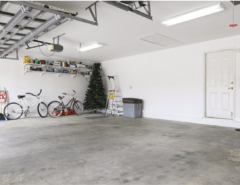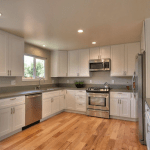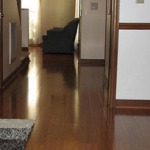Whether you’ve started browsing for flooring or you’re choosing between two styles of engineered flooring, you should consider a few questions to make sure you’re getting the right product for your space. Ask the following eight questions when shopping for engineered wood flooring.
What Hardwood Species Should I Choose?

Left to right: Walnut SKU: 10068963; Hickory SKU: 10068964; Maple SKU: 10074815; Oak SKU: 15000649
All engineered wood flooring starts with a hardwood base. You can choose from a long list of hardwood species to find one that’s ideal for your space. While color and grain are important, especially when it comes to style, you’ll also want to consider the durability and maintenance level of the hardwood to makes sure that it meets your needs.
For a natural look that can brighten any space, consider maple. It’s one of the hardest hardwood species and makes one of the most durable types of engineered flooring. For a reddish tone that can warm any room, consider oak. This species isn’t quite as hard as maple, but it still makes for a solid choice. For a darker look, consider hickory. This wood is one of the strongest and most durable hardwood species, and it doesn’t require much maintenance.
What Material Is in the Top Layer?
Several layers go into each panel of engineered flooring, including hardwood veneer, plywood, and high-density fiberboard (HDF). After installation, however, you’ll see only the top layer. Also known as the wear layer, this part is arguably the most important component of your engineered flooring. After all, this layer complements the room’s design, and it’s also the part that receives the most wear and tear.
When you purchase high-quality engineered flooring, the top layer should feature solid wood. If it isn’t made of genuine hardwood, you may be better off shopping for laminate or composite flooring instead.
How Thick Is the Top Layer?

Before purchasing engineered wood flooring, always confirm the thickness of the top layer. Even with regular maintenance, all flooring wears down over time. If the engineered flooring you choose has a relatively thin top layer, it could wear down quickly and require replacement sooner than you’d planned. In contrast, a thicker top layer can last longer, which may make the flooring a better investment.
Many types of engineered wood flooring feature a top layer between 0.5 and 6 millimeters. Always aim to purchase flooring with the thickest possible top layer, ideally at least 2 millimeters thick.
What Type of Adhesive Does This Engineered Flooring Contain?
Every type of engineered wood flooring contains adhesives that hold together the various layers. Many manufacturers use adhesives that strike a balance between durability and health and safety. However, some hardwood flooring may contain adhesives designed to last for decades, but they could release harsh volatile organic compounds (VOCs).
While you can’t avoid adhesives completely, you can seek out types that aren’t quite as harsh. To make sure you’re choosing flooring made to last and make you feel great, opt for a style with formaldehyde-free adhesives. Look for flooring that contains nontoxic, water-resistant adhesives designed for extra strength.
How Does Engineered Flooring Stand Up to Damage?
Like hardwood flooring, engineered flooring is known for its durability. The type of hardwood in the wear layer has a significant effect on the strength and durability of the flooring, and the number of layers affects its overall stability and ability to withstand impacts. Choosing the hardest wood veneer and the highest number of layers can ensure that you’re purchasing the most durable engineered wood flooring.
However, furniture, people, and pets can all scratch, dent, or gouge engineered flooring. Since you can’t sand or refinish engineered wood flooring frequently, your best bet is to prevent damage in the first place.
What’s the Best Way to Keep Engineered Flooring in Good Condition?

To keep your engineered flooring looking like new for years to come, make a point of cleaning it regularly. Sweep, vacuum, or mop the floor (damp, not wet!) at least once a week to prevent grit and sand from scratching or wearing away the top layer. Never use harsh cleaners when you mop, as they could break down the finish. Instead, use natural or gentle cleaning products.
Add furniture pads to chairs, tables, and sofas to prevent scratches and gouges in the floor. If you have pets or if you frequently wear hard-soled shoes indoors, consider placing a few area rugs on top of the engineered flooring. Rugs will add color and texture to the room while protecting your floors.
How Much Does Engineered Flooring Cost?
Since you’ll find many styles and types of engineered flooring on the market, you can also expect to encounter a range of prices. On average, mid-range engineered wood flooring costs $7.50 per square foot. Budget-friendly engineered flooring costs about $5 per square foot, while high-end options average $10 per square foot. If you’re planning to install engineered flooring in a bedroom, you’ll pay an average of $900. For a typical living room, you’ll spend about $2,750.
Keep in mind that costs for tools and subfloor repairs and replacements will add to the overall cost. If you’re planning to hire a local contractor to complete the installation, expect to pay an average of $5 per square feet in labor costs.
Will Engineered Flooring Work in My Room?
Engineered wood flooring works well in almost any room in your home, and you can install it in some areas where hardwood flooring wouldn’t work. You can install engineered flooring in bedrooms, living rooms, and family rooms — even those rooms below grade. Since engineered flooring holds up to humidity and moisture, it also works in basements. You can install engineered flooring over radiant heating systems, although you may need to take special precautions during installation to prevent damage.
While some of the most durable types of engineered wood flooring, such as hickory, work well in kitchens, few can withstand constant moisture. Avoid installing engineered flooring in bathrooms, as the water and humidity can damage even the strongest engineered flooring.
No matter your budget or your style preferences, engineered flooring can be a great choice for any room. Find the ideal engineered hardwood flooring and give your space the best look possible.
Resources:
https://blog.builddirect.com/how-to-choose-an-engineered-wood-floor/
https://blog.builddirect.com/reasons-engineered-wood/
https://www.builddirect.com/Engineered-Hardwood-Floors
https://www.builddirect.com/learning-center/faq/engineered-hardwood-flooring/
https://www.builddirect.com/learning-center/flooring/care-engineered-hardwood-flooring/






















